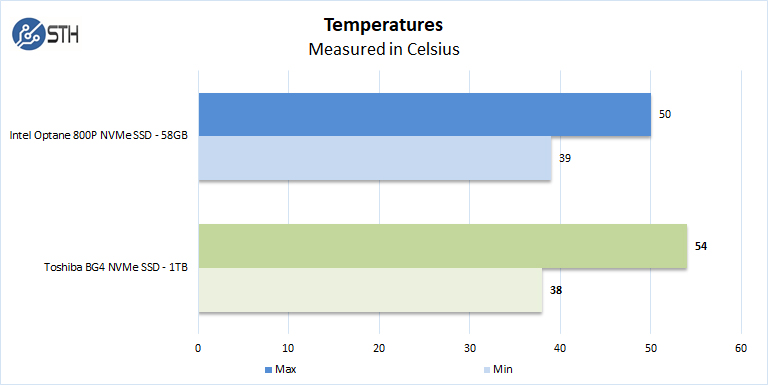Toshiba BG4 M.2 2230 NVMe SSD Temperatures
For the market these drives are targeted at, low power and temperature operation can be important.

Overall the BG4 runs cool but does reach into the 54C range under load. Our test setup does not have a heat sink on the BG4 which would help lower temperatures and even a fan directed at the SSD would further cooling performance.
Toshiba BG4 M.2 2230 NVMe SSD Market
We specifically used the Intel Optane 800p here to show something. Intel has been pushing low capacity Optane bundles and suggesting that it is better to use Optane cache and a larger hard drive. The Toshiba BG4 shows something different. One can simply use NVMe SSDs with the capacity you need and not require one to set up caching and use multiple drives at a higher power level.
There are a few things we wanted to note. First, not every motherboard supports 30mm NVMe SSDs. If you are a notebook vendor, you are probably soldering the BGA to the PCB anyway. If you are an embedded appliance manufacturer, you need to ensure your platform has 30mm mounting points. We have numerous designs in the lab that start at 42mm. Toshiba is pushing new ground at 30mm and is one of the only vendors to offer such a small NVMe device.
The Toshiba BG4 is not designed to be the fastest database SSD on the planet. It is designed more for read heavy workloads and that is great for a large segment of the market. As we are starting to see more server vendors utilize M.2 2280 boot SSD configurations, we think the M.2 2230 form factor with the BG4 may be a better option to design for.
Final Words
Overall, the Toshiba BG4 is not designed to be the fastest SSD in the world. With that said, it may be the fastest 30mm drive option out there. This is a big deal. For notebooks, the BGA package can instead be soldered onto the motherboard and PCIe traces linked directly to the CPU. Likewise, we have started to see embedded platforms utilize a similar design, such as the embedded server platform in our Gigabyte MA10-ST0 review. We would love to see embedded platforms with a BG4 NVMe SSD instead of eMMC.
For servers that would generally prefer the M.2 2230 iteration, things are different. There is generally enough room, even in dense designs like the Supermicro BigTwin, where two M.2 2280 drives per node are easy to accommodate. For many of these applications, the ability to switch from SATA to NVMe provides a solid performance boost.
We know that this SSD is not designed for heavy write workloads. Sync write speeds are very poor indeed owing to the lack of onboard PLP DRAM. For the BG4’s target market, this simply does not matter. The unique aspect of the product is its ability to be extremely small at 30mm in the M.2 2230 form factor or a single BGA package for integration. With that in mind, the performance is a vast upgrade over previous generation SATA offerings making it suitable as a primary drive for many client and embedded applications.




Where can I buy this???